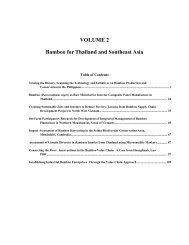WBC-VIII-Vol.4 – Resources – Forestry, Plantations and ... - BambuSC
WBC-VIII-Vol.4 – Resources – Forestry, Plantations and ... - BambuSC
WBC-VIII-Vol.4 – Resources – Forestry, Plantations and ... - BambuSC
You also want an ePaper? Increase the reach of your titles
YUMPU automatically turns print PDFs into web optimized ePapers that Google loves.
internode length, height, girth, straightness, number of culms/clump <strong>and</strong> disease resistance of the culms. The<br />
maximum <strong>and</strong> minimum scores of these characters are decided on the basis of the phenotypic average value of<br />
base population of the species. The total score while evaluating the c<strong>and</strong>idate plus clump is fixed to 100. The<br />
c<strong>and</strong>idate clump, if attains the pre decided score <strong>and</strong> more would be declared as plus clump. After that, the<br />
rhizomes/culms will be taken from the selected plus clumps for establishment of germ-plasm bank <strong>and</strong> further<br />
multiplication using various proliferation techniques for supplying improved planting stock in plantation<br />
activities. Selection of high yielding clones coupled with suitable agro techniques for raising bamboo plantation<br />
can improve bamboo productivity substantially.<br />
Keeping such rational approach in view <strong>and</strong> using selection index method (Banik 1995) as discussed above, the<br />
superior genotypes of the priority bamboo species in Northeast India were selected <strong>and</strong> conserved in<br />
bambusetum at Rain Forest Research Institute (RFRI), Jorhat, Assam (Table 2). These plus clumps are under<br />
genetic testing in multi-location trials at different places for further recommendations <strong>and</strong> deployment in the<br />
country.<br />
Table 2. Superior Genotypes of Bamboo at Bambusetum - RFRI<br />
S.N. Species No. of Plus Clumps<br />
1.<br />
2.<br />
3.<br />
4.<br />
5.<br />
6.<br />
Bambusa tulda<br />
B. bambos<br />
Dendrocalamus hamiltonii<br />
Bambusa balcooa<br />
B. nutans<br />
B. pallida<br />
Collection <strong>and</strong> Conservation of Plus Plumps in Germ-plasm banks<br />
50<br />
50<br />
50<br />
49<br />
25<br />
25<br />
Both in-situ <strong>and</strong> ex-situ conservation measures are being adopted to preserve the genetic resources of bamboos<br />
in India. In-situ conservation measures include establishment of preservation plots in every state, where the<br />
biodiversity is being periodically monitored. In addition, there are 10 biosphere reserves (Maikhuri et al. 1998),<br />
85 national parks <strong>and</strong> 450 wildlife sanctuaries (Anon 1997), which include the natural habitat of bamboo also.<br />
The bamboos are also protected by the local people in sacred groves. The major limitations of in-situ<br />
conservation are that natural st<strong>and</strong>s of bamboo are scattered in pockets over large areas making it difficult to<br />
declare several bamboo reserves.<br />
Ex-situ conservation activities for preservation of important genetic resources of bamboo need more emphasis.<br />
So far these activities are limited to establishment of bambusetum <strong>and</strong> germ-plasm banks. Clumps with higher<br />
scores (as discussed in Selection of Bamboo Plus Clumps) designated as plus clumps are used for germ-plasm<br />
conservation. Germ-plasm of selected clumps in the form of off-sets/rhizomes from 1-2 years old clumps should<br />
be collected in replicates <strong>and</strong> planted in the germ-plasm banks/bambusetums. Rhizomes are dug out from the<br />
soil preferably during February to May each year. Special care must be taken during collection so that the buds<br />
<strong>VIII</strong> World Bamboo Congress Proceedings Vol 4-18




